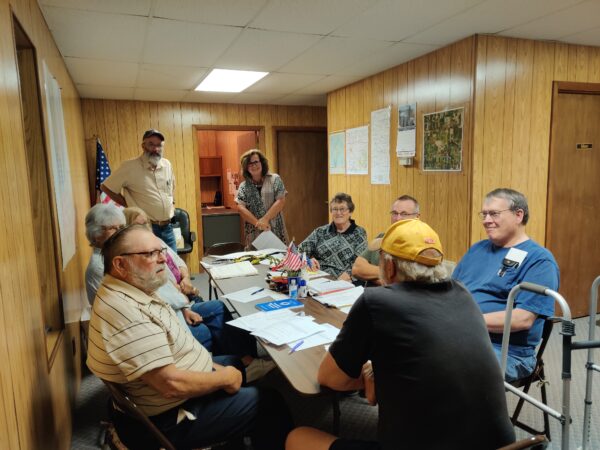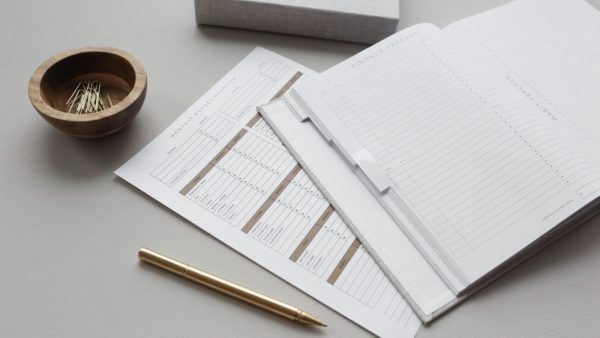
Prudent Board Training in Prudence Island, Rhode Island
Among small and rural communities, those with water utilities face additional complexities that range across a vast spectrum of realities and considerations. These can range from topics such as source water programs and additional water treatment to emergency response plans and access to funding to managerial support and training. RCAP Solutions has continued to help and serve communities using a Technical, Managerial, and Financial (TMF) centered approach. RCAP Solution’s broad spectrum of tools and experiences allows the Technical Assistance Providers (TAPs) to meet any unique needs of a community. For a small community in Rhode Island, all the above are just some of the hurdles faced by a board of valiant individuals, who are trying to create community sustainability.
Prudence Island sits in the middle of Narraganset Bay, Rhode Island. Prudence Island Water District (PIWD) is a drinking water community on the island with 335 customers and is managed by a board of five volunteers. Adding to the previous hurdles, PIWD is also a small seasonal island community, which demands the technical, managerial, and financial processes and planning to be, very creative. To a small board that is volunteering a lot of time and energy, the need for managerial support becomes a large part of keeping consistency and continuity to endure the challenges of producing safe water for the community. One specific challenge for a community like this stems from location limitations, which create more complexity for managerial and financial planning. A couple examples of location limitations include having no road access, and limited access to critical replacement parts. These factors impact asset management and financial sustainability. For example, having to purchase a replacement pump, which holds additional considerations like costs in shipping, available carriers, and a possible timeline to receive a crucial asset. For the board of PIWD, attempting plans to improve water quality and fulfilling simultaneous compliance to regulations are mountainous with consideration of their unique challenges.
To assist the board and provide beneficial options, the approach from RCAP Solutions was to support funding opportunities and increase managerial capacity. This two-fold methodology focused on financial and managerial aspects specific to the RCAP Solutions’ TMF approach. The services RCAP Solutions provided included an income survey, a disadvantaged criteria assessment, and a series of targeted board trainings. This approach included preliminary characteristics and information gathering, depicting the need for additional data and review. For example, the customer base for the district is primarily residential with little prospects for expansion, thereby affecting opportunities for increasing customer base and revenue streams from business or commercial property. Looking at the existing data PIWD is not designated as a census-marked area. The district falls within the US Census Bureau data as Block Group 3, Census Tract 401.05 of Newport County, RI. Any other available data from the US Census incorporates the town of Portsmouth, RI, and limits the eligibility for funding programs. Important data was collected and used to complete a disadvantaged criteria assessment for PIWD. The assessment used information from the US Census, the community, the Rhode Island Infrastructure Bank (RIIB), the Rhode Island Department of Health (RIDOH), and an RCAP Solutions Community Characteristic Income Survey. The result of the assessment identified qualifying criteria that narrate the needs and desired outcomes for potential projects and associated financial responsibility and debt service. The final approach for PIWD was for RCAP Solutions to provide a series of board trainings, targeting specific conversations to increase managerial capacity and sustainability.
RCAP Solutions recognizes those individuals who serve as board members and oversight committees, and work to improve and empower better sustainable communities. Behind any successful managerial group and plan is a supportive system. RCAP Solutions is continually committed to supporting a framework that serves to increase capacity and sustain drinking water leadership. As economies shift and fiscal cycles continue, the cost to provide the same services is increasing exponentially. Small systems are experiencing project costs that revenues may not support. Such discouragement is unshakable but for small and rural communities, especially the disadvantaged, they should not feel like they are alone on an island. The impact of RI state funding programs and the United States Department of Agriculture Rural Development (USDA RD), create a way for small and rural communities to, not only survive but thrive. With the direct technical assistance funding from these funders, and the grants that allow RCAP Solutions to continue serving, communities and boards can get the support needed to maintain a sustainable future.

Planning for Success and Security – Providing Assistance Without a Back-Up Plan Puts Everyone at Risk
A town manager in Maine had suddenly found himself in charge of his small community water system. The small town’s water operator had suddenly taken ill and was hospitalized. The back-up operator had passed away six months ago. Unfortunately, this avoidable story is not uncommon.
The community was quite remote, and the town manager was in desperate need of an operator who could help keep their two treatment plants operational. The system has several treatment phases including pre-chlorination, filtration, aeration, and fluoridation that need to be monitored and maintained. Several days and several frantic calls later, they were connected to a licensed contract operator who was willing to drive the two hours to investigate the situation.
Upon arrival, the contract operator was greeted by a public works employee who was set to be cross-trained in the water department but had no working knowledge of the treatment plants. The public works employee confessed that the regular operator, now hospitalized, had told him that the information was “all up here” as he pointed to his brain. It seemed the hospitalized operator had felt his job was threatened and closely guarded the operational information. That fear, which is often shared by undervalued operators, is unfortunate, as it created a stressful situation for everyone left in his wake.
By the end of day one, the contract operator and the public works employee were able to determine where the maintenance logs and the test kits were located. The contract operator was successfully able to show the public works employee how to run the daily tests and record the meter readings. Then the contract operator began searching for the operation and maintenance (O&M) manual or any standard operating procedures (SOPs), to figure out how the system worked, but to no avail. There were no clear procedures found to follow to ensure the system was running properly. Under stacks of unfiled paperwork, the contract operator was able to find an emergency response plan that hadn’t been updated in 18 years, which is recommended to be updated annually, but it had very little detail and was of little help. With the assistance of contract operator’s administrative office, they were able to piece together clues as to how the facilities operated through state records and other pieces of information.
By day two, alarms began to sound, though no one really knew that alarms were sounding, as the hospitalized operator was the only one getting the notifications. It was upon arrival to the plant that the public works employee observed the chlorine feed tank had run dry. The proper ratio to prepare the chlorine solution was unknown. The fluoride pump appeared to be unplugged. The public works employee was untrained in how to properly handle these dangerous chemicals. The contract operator stepped in again to help batch the chemicals and get the chemical feeds pumping. The contract operator’s best recourse and advice was to encourage the town manager and the public works employee to reach out to their regular operator, while in the hospital, to get guidance. This was not an ideal situation for anyone.
This emergency could have been avoided and continuity in service could have easily been maintained by having an O&M manual readily available. The O&M manual serves not only as a tool for the operation and maintenance of the facilities for the personnel of the plant; but it also serves as a road map for those who must step in when the primary operations crew is unavailable. For the manual to be effective, vital information must be easy to find, quickly and efficiently. The O&M manual is designed to provide treatment system personnel and the back-up operator the proper understanding of techniques and reference protocols necessary to efficiently operate their facilities. Having an O&M manual which includes well written SOPs and an emergency response plan will ensure that operations will be continued in a situation when new or temporary staff must be trained quickly.
Moving forward, the contract operator has been retained as the town’s back-up operator. His crew has already begun planning to assist with the development of a functional O&M manual to avoid this situation in the future. The grateful town manager is now keenly aware of the need to document everything and to have a back-up plan in place.
When developing an O&M manual, you should ask yourself:
What do I do on a daily and weekly basis to maintain my water and/or wastewater treatment system?
Do these activities or pieces of equipment that need maintenance involve SOPs, manufacturer’s specifications, or record keeping logs?
Do I have the right tools?
What documents or logs do I need to develop?
“Thank you so much for the help you guys have provided. You have been wonderful to work with. We will certainly be in touch.” – Town Manager of a Little Town, Maine, USA

Plan to Maintain, Plan to Sustain
Is your community effectively operating profitable and sustainable water and sewer systems, or are you simply getting by? With our communities’ ever-changing dynamics, our rural drinking water and wastewater systems will need to implement new administrative strategies and management tools to adapt to the increased regulatory requirements and environmental complexities they face daily and into the future. As responsible community leaders, we must allow the systems to operate using a “business model” for long-term sustainability. Sustainability will help address new and stricter regulatory requirements, changing populations, increased service demands, limited water supplies, a highly variable climate, aging infrastructure, and limited state and federal funding.
Cost estimates for water and wastewater system needs in the rural U.S. total billions of dollars nationwide. The existing state and federal funding sources can only meet a fraction of this need, even with the new influx of infrastructure dollars through the Bipartisan Infrastructure Law (BIL). Therefore, approaches to reducing the gap between what is needed and what funds are available will need to be adopted. In addition, funders want assurance their investments in water and wastewater infrastructure will be adequately managed and maintained to ensure long-term sustainability and security. This assurance will require water and wastewater systems to present convincing evidence that they possess adequate financial, technical, and managerial capacity to maintain/sustain the infrastructure necessary to provide the service their customers expect. State and Federal funds only cover the cost of capital outlays, but not ongoing operation and maintenance over time. In addition, the new or upgraded system must remain in full compliance with the Safe Drinking Water Act (SDWA) or the Clean Water Act (CWA), and any additional state or local regulations.
It is recommended that systems adopt a “business model” for managing the delivery of services. This plan should include:
A five-year financial plan with a fully allocated rate structure;
An asset management plan;
A water accounting system with full metering;
Full compliance with the Safe Drinking Water Act (SDWA) or the Clean Water Act (CWA), and your state primacy/regulatory agency requirements ;
A governance structure adequate for proper management and oversight; and
Participation in regional efforts to collaborate on long-term solutions.
A financial plan has two components: a forecast of the utility’s future financial needs (such as operating and capital needs) and an identification of how to fund those future financial needs.
A Capital Improvements Plan (CIP) is a written document that specifies and satisfies the following questions and is typically based on a utility’s asset management program:
What facility improvements will be needed in the future?
When will the improvements be needed, and when will they be undertaken?
How much will the improvements cost?
What financing options are available for the improvements?
A CIP is a multi-year planning document that identifies capital improvement needs and is usually done in 5-, 10- and even 20-year increments. This will help your utility’s board and management make informed decisions about rate setting, future debt-service requirements, and future revenue requirements. In preparing a CIP, there are several things to consider:
Will current facilities reach their design capacity soon?
What new equipment, services, or facilities are needed to meet the demand of your customers?
What current system components will require significant repair, rehabilitation, or replacement?
Will failure to upgrade existing facilities result in regulatory violations or enforcement actions?
What are the most critical improvement needs, and what is the urgency of meeting those needs?
What benefits do the improvements provide to the system and its customers?
What are the available options for financing the improvements?
Can regular resources of the systems fully fund future capital projects, and which projects will require outside financing?
How do financing options for improvements relate to the annual budgeting process?
Use the assistance of a consulting engineer to prepare cost estimates for major capital improvement projects that the community will need in the future.
RCAP and Midwest Assistance Program, Inc. (MAP), RCAP’s regional partner, assists communities by being a resource to help plan, prepare, and execute a comprehensive strategy to sustain your community’s system(s) now and into the future. To be a good steward of your infrastructure, technical, managerial, and financial responsibilities are interconnected – one cannot be sustainable without the other. As a community leader, you need to enable the community to “look around corners” to identify potential expenses and maintenance to their systems and provide a fair and equitable rate structure for the community to “invest” in the future of your most valuable resource.
RCAP’s Managerial and Financial Hub has resources on management, rate setting, applying for infrastructure funds, and regionalization.
REFERENCES
A Guidebook of Financial Tools. USEPA, Environmental Finance Program.
The Basics of Financial Management for Small-communities Utilities. RCAP Rural Communities Assistance Partnership.
Small System Guide to Developing and Setting Water Rates, Rural Community Assistance Program, Inc.
Rate Setting and Capacity Development, the Environmental Finance Center at the University of Maryland.

Budgeting and Financial Management
Basics of Financial Management Guidebook
RCAP’s guidebook for small communities on financial policies and controls, budgeting, and monitoring of financial performance.
The Basics of Financial Management for Small-community Utilities: A Webcast on Financial Management (Part 1)
A recorded webcast that is a companion to RCAP’s The Basics of Financial Management for Small-community Utilities
The Basics of Financial Management for Small-community Utilities: A Webcast on Financial Management (Part 2)
A recorded webcast that is a companion to RCAP’s The Basics of Financial Management for Small-community Utilities
Budget How-Tos
This document includes tips on creating a budget for a water board.
Budget Worksheet for Water Systems
A worksheet in Microsoft Excel format that provides a general overview of the annual budget. Calculations are performed automatically within the Excel program.
RCAC: Financial Planning: A Guide for Water and Wastewater Systems
These guidebooks address core issues regarding water system sustainability: auditing water use to reduce water losses and increase system efficiency, financial planning and management to ensure sufficient revenues to sustain operations, and asset management to allow the system to provide a sustained level of service at the lowest life cycle cost.
EPA: Water Utility COVID-19 Financial Impact Tool
A tool that can help drinking water, wastewater, and stormwater utilities assess the financial impact of the COVID-19 pandemic on the utility’s cashflow.
UNC Environmental Finance Center: Tools To Assist Water Utilities With Financial Decision Making
The EFC at UNC has created several free tools to assist water utilities in addressing the challenges commonly seen in communities.

Rate Setting & Affordability
Formulate Great Rates Guidebook
RCAP’s step-by-step guide on setting rates for your water system that cover expenses, are fair and equitable and are easy to administer.
Formulate Great Rates: A Webcast on Setting Rates in Small-Community Utilities (Part 1)
A recorded webcast that is a companion to RCAP’s Formulate Great Rates: The Guide to Conducting a Rate Study for a Water System.
Formulate Great Rates: A Webcast on Setting Rates in Small-Community Utilities (Part 2)
A recorded webcast that is a companion to RCAP’s Formulate Great Rates: The Guide to Conducting a Rate Study for a Water System.
Rate Guide Supplemental Materials (Excel)
Excel workbook supplement to the Formulate Great Rates guidebook.
RCAP Blog: Three Things to Do Before a Rate Change
A blog post outlining three steps to take before a rate change.
UNC Environmental Finance Center: Tools To Assist Water Utilities With Financial Decision Making
The EFC at UNC has created several free tools to assist water utilities in addressing the challenges commonly seen in communities.
UNC Environmental Finance Center: Finance Dashboards
Rates Dashboards are designed to assist utility managers and local officials to compare and analyze water and wastewater rates against multiple characteristics, including utility finances, system characteristics, customer base socioeconomic conditions, geography, and history.
EPA: Compendium of Drinking Water and Wastewater Customer Assistance Programs
A document describing the benefits, implementation, and examples of customer assistance programs (CAPs) throughout the country.
UNC Environmental Finance Center: Navigating Legal Pathways To Rate-Funded Customer Assistance Programs
This project focuses on the legality of how customer assistance programs can be financed by the utility.
RCAP Educational Program Materials
Webinar: Understanding and Improving Your Water System’s Bill Collection Rate
This webinar explored calculations to measure the bill collection rate, how that rate is tied to the rate setting process, and strategies to improve the rate.

Water Loss Control
AWWA: Water Loss Control
The latest version of AWWA’s industry-standard free water audit software.
Southwest Environmental Finance Center: Water Loss Switchboard
A repository of documentation and tools related to measuring and addressing non-revenue water.
Southwest Environmental Finance Center: The Water Audit Handbook for Small Drinking Water Systems
Guide to help small water systems prepare a water audit using the AWWA/IWA Water Audit Method.
EPA: Water Audits and Water Loss Control for Public Water Systems
Documents introducing water loss control and information on the use of water audits in identifying and controlling water losses in public water systems.
Alliance for Water Efficiency: Utility Water Loss Control
Tools and resources on the water audit and data validity including an interactive map of state-level water loss laws in the United States.
Texas Water Development Board: Water Loss Audit Resources
Guidance documents and calculators to help complete a water audit. These items are generally applicable to utilities across the country.
Southwest Environmental Finance Center: Break Rate Analysis Tool
Interactive web tool that compares annual main breaks from your system to the US/Canadian average break rates for 7 pipe materials.
Missouri Rural Water Association: Water Loss Tracking Tools
Interactive web tools to calculate the volume of water lost from different types of breaks, well drawdowns, hydrant and pipe flushes, and other activities.

Veterans Working in Water
EPA: Water Workforce Veteran Promotion
Tips for water and wastewater utilities considering hiring veterans and promote interagency activities to improve career opportunities for disabled Veterans in the water sector.
EPA: Guide for Applying Military Occupational Specialties (M.O.S.) to Civilian Drinking Water and Wastewater Operations
Guide highlighting relevant MOSs and tips for water and wastewater utilities considering hiring veterans.
AWWA: Veterans Workforce Resources
The Veterans Workforce Initiative has developed toolkits for employers looking to hire Veterans and flyers for Veterans interested in the water sector.
U.S. Department of Labor: Veterans’ Employment and Training Service
The Veterans’ Employment and Training Service (VETS) is committed to helping America’s veterans and separating service members by preparing them for meaningful careers, providing employment resources and expertise, and protecting their employment rights.
U.S. Department of Veterans Affairs: Veterans Employment Toolkit
In this toolkit, you can learn about Veterans and the military, such as what Veterans bring to the workplace and what the military structure and culture is like.
Work for Water: Veterans Focus
This site provides resources for veterans to find careers in the water industry.
U.S. Department of Labor: Veterans.gov
This webpage provides resources for veterans and military spouses.
Career One Stop: American Job Centers
American Job Centers (AJCs) provide free help to job seekers for a variety of career and employment-related needs
U.S. Chamber of Commerce Foundation: Hiring our Heroes
Hiring Our Heroes is a nationwide initiative to help veterans, transitioning service members, and military spouses find meaningful employment opportunities.
RecruitMilitary.com
This site provides resources for employers looking to recruit veterans.
Disabled American Veterans: National Employment Program
DAV will sponsor job fairs including virtual events, to connect veterans with employers nationwide who are committed to hiring them.
RallyPoint: Business Services
Social media site for employers to engage the military community.
Career One Stop: Civilian-to-Military Occupation Translator
Identify relevant military experience by matching your civilian job opening to military careers that use similar skills.
O*Net OnLine: Military Occupational Classification Crosswalk Search
Allows for users to find civilian-equivalent occupations for military codes and titles.
USAA: Veteran Employment Roadmap
This site has created and compiled the best resources for hiring veterans and organized them in three categories: prepare, recruit, empower.
RCAP Educational Program Materials
Webinar: Continuing to Serve: How to Recruit Retiring Military Personnel into the Water Sector
This webinar explored how skills learned in the military can be an ideal fit for drinking water systems, while utility work can be an ideal fit for veterans transitioning back to civilian life. The webinar also described the process of how retiring military personnel find new jobs and offered practical advice for water systems to get their job postings in the hands of veterans.

Water Finance and Management Libraries, Blogs & Podcasts
RCAP’s A Drop of Knowledge
RCAP’s monthly online newsletter with information for small, rural and tribal drinking water and wastewater systems
WaterOperator.org: Resource Library
Portal for information from across the water industry that saves time, answers questions, and provides opportunities for ongoing learning at your own pace.
Edmunds GovTech: Utility Information Pipeline
Blog on water and wastewater financial management and billing.
IB Environmental: Ripple Effects – An Environmental Blog
This blog aims to increase the appreciation for water resources and promote sound environmental policy through research, education, and action.
Manny Teodoro: Blog
This blog discusses water policy, management, and finance.
Southwest Environmental Finance Center: Blog
Blog on drinking water and wastewater technical, managerial, and financial capacity.
UNC Environmental Finance Center: The Environmental Finance Blog
Blog to support communities interested in sustainable and innovative financing mechanisms for delivering environmental services such as drinking water and wastewater.
Water in Real Life Podcast
Podcast from the H2duO of Rogue Water Lab focused on communicating about water through story.
Words on Water Podcast
A podcast featuring conversations with influential and interesting people from the water sector and news from the Water Environment Federation.
Waterloop Podcast
Podcasts on conversations about water solutions.
The Water Values Podcast
This podcast series explores water issues from a variety of perspectives with the goal of uncovering the true value of water.
Water We Talking About? Podcast
A podcast for water and wastewater technology vendors and service providers.

Energy Management and Conservation Resources
Sustainable Infrastructure for Small System Public Services: A Planning and Resource Guide
This planning and resources guide includes a step-by-step process for utility decision makers, staff and community members wanting to operate increasingly efficient utilities.
Five Things You can do to Save on Energy in your Utility
This document aims to help understand your facilities and your energy usage, you can make good decisions and implement positive changes for your community.
Energy Efficiency at Wastewater Treatment Facilities
This video presents to those in small, rural communities who are responsible for managing and overseeing wastewater treatment systems – boards or other governing bodies, staff and decision-makers – opportunities for saving on energy costs (many opportunities in the video also apply to drinking water facilities).
National Rural Water Association: Energy Efficiency Program
NRWA’s Energy Efficiency Technical Assistance Program is designed to promote energy efficient practices in small water and wastewater systems, including energy assessments and recommended energy efficient practices and technologies.
NC State University: Database of State Incentives for Renewables & Efficiency
A database of loan and grant programs available to fund energy efficiency upgrades.
EPA: Energy Use Assessment at Water and Wastewater Systems
Guides for an Excel-based tool that small- to medium-sized systems can use to conduct a utility bill and equipment analysis to assess individual baseline energy use and costs.
Energy Star Portfolio Manager
An online tool to measure and track energy and water consumption, as well as greenhouse gas emissions. Use it to benchmark the performance of one building or a whole portfolio of buildings, all in a secure online environment.
New Hampshire DES: Guidance for the Energy Efficient Design of Drinking Water System Infrastructure
The document is intended to be used as guidance to improve the energy efficient design of water system pumping stations, infrastructure and water treatment facility upgrades.
UNC Environmental Finance Center: Electricity Baseline Builder for Water Utilities
This tool allows you to see how much electricity your water system is currently using and track how much you save, or have already saved, with new energy efficiency projects.